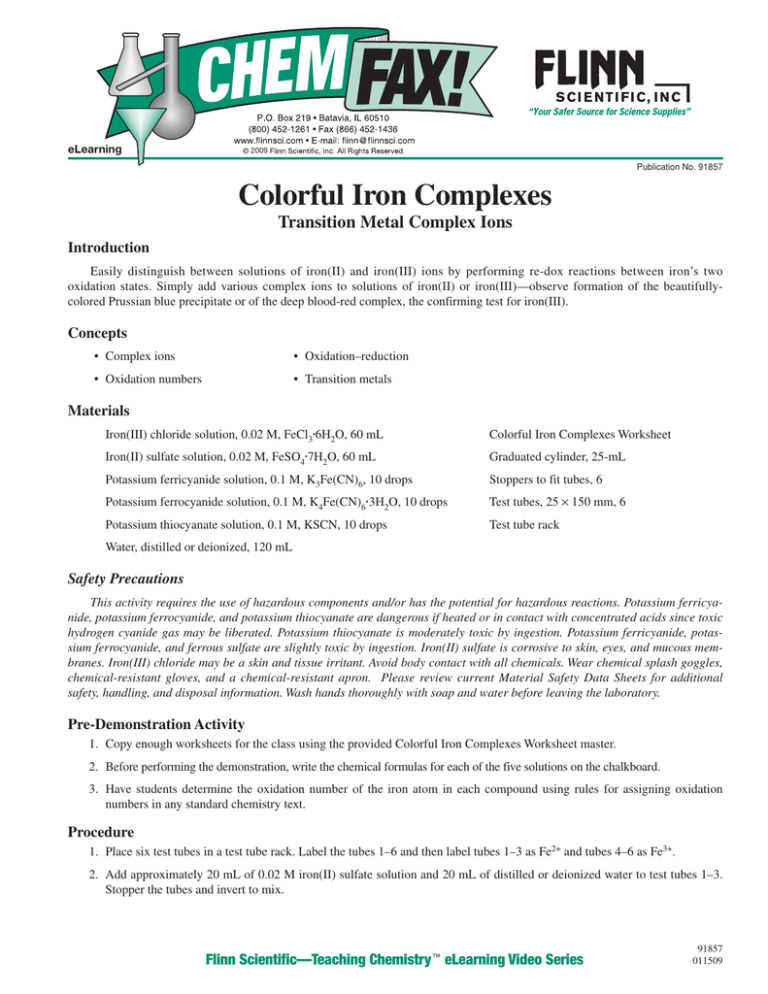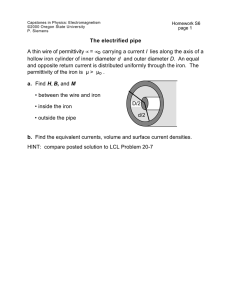
eLearning
2009
Publication No. 91857
Colorful Iron Complexes
Transition Metal Complex Ions
Introduction
Easily distinguish between solutions of iron(II) and iron(III) ions by performing re-dox reactions between iron’s two
oxidation states. Simply add various complex ions to solutions of iron(II) or iron(III)—observe formation of the beautifullycolored Prussian blue precipitate or of the deep blood-red complex, the confirming test for iron(III).
Concepts
• Complex ions
• Oxidation–reduction
• Oxidation numbers
• Transition metals
Materials
Iron(III) chloride solution, 0.02 M, FeCl36H2O, 60 mL
Colorful Iron Complexes Worksheet
Iron(II) sulfate solution, 0.02 M, FeSO47H2O, 60 mL
Graduated cylinder, 25-mL
Potassium ferricyanide solution, 0.1 M, K3Fe(CN)6, 10 drops
Stoppers to fit tubes, 6
Potassium ferrocyanide solution, 0.1 M, K4Fe(CN)63H2O, 10 drops
Test tubes, 25 × 150 mm, 6
Potassium thiocyanate solution, 0.1 M, KSCN, 10 drops
Test tube rack
Water, distilled or deionized, 120 mL
Safety Precautions
This activity requires the use of hazardous components and/or has the potential for hazardous reactions. Potassium ferricyanide, potassium ferrocyanide, and potassium thiocyanate are dangerous if heated or in contact with concentrated acids since toxic
hydrogen cyanide gas may be liberated. Potassium thiocyanate is moderately toxic by ingestion. Potassium ferricyanide, potassium ferrocyanide, and ferrous sulfate are slightly toxic by ingestion. Iron(II) sulfate is corrosive to skin, eyes, and mucous membranes. Iron(III) chloride may be a skin and tissue irritant. Avoid body contact with all chemicals. Wear chemical splash goggles,
chemical-resistant gloves, and a chemical-resistant apron. Please review current Material Safety Data Sheets for additional
safety, handling, and disposal information. Wash hands thoroughly with soap and water before leaving the laboratory.
Pre-Demonstration Activity
1. Copy enough worksheets for the class using the provided Colorful Iron Complexes Worksheet master.
2. Before performing the demonstration, write the chemical formulas for each of the five solutions on the chalkboard.
3. Have students determine the oxidation number of the iron atom in each compound using rules for assigning oxidation
numbers in any standard chemistry text.
Procedure
1. Place six test tubes in a test tube rack. Label the tubes 1–6 and then label tubes 1–3 as Fe2+ and tubes 4–6 as Fe3+.
2. Add approximately 20 mL of 0.02 M iron(II) sulfate solution and 20 mL of distilled or deionized water to test tubes 1–3.
Stopper the tubes and invert to mix.
Flinn Scientific—Teaching Chemistry eLearning Video Series
91857
011509
3. Add approximately 20 mL of 0.02 M iron(III) chloride solution and 20 mL of distilled or deionized water to test tubes 4–6.
Stopper the tubes and invert to mix.
Part A. Ferrocyanide ions, Fe(CN)64– [Iron in the +2 oxidation state]
4. Add 5 drops of 0.1 M potassium ferrocyanide solution to Tube 1. Since both sources of iron are in the +2 state, the
notable deep-blue precipitate does not form. Instead a light blue precipitate of potassium iron(II) hexacyanoferrate(II),
K2Fe[Fe(CN)6], forms according to Equation 1.
→
Fe2+ + 2K+ + [Fe(CN)6]4–
K2Fe[Fe(CN)6](s)
Light blue ppt
Equation 1
5. Add 5 drops of 0.1 M potassium ferrocyanide solution to Tube 4. A deep-blue precipitate will form according to
equation 2, due to the presence of both iron(II) and iron(III) ions. This resulting deep blue precipitate is iron(III)
hexacyanoferrate(II), Fe4[Fe(CN)6]3, or Prussian blue. Have students determine the oxidation number of each iron atom in
the complexes in Equations 1 and 2.
→
4Fe3+ + 3[Fe(CN)6]4–
Fe4[Fe(CN)6]3
Prussian blue
Equation 2
Upon standing for 5–10 minutes, the solution in Tube 1 will turn darker blue as the iron(II) is slowly oxidized to iron(III)
by atmospheric oxygen to form the same Prussian blue precipitate as in equation 2.
Part B. Ferricyanide ions, Fe(CN)63– [Iron in the +3 oxidation state]
6. Add 5 drops of 0.1 M potassium ferricyanide solution to Tube 2. A deep-blue precipitate will form with the iron(III) sulfate. In this reaction, the ferricyanide ions, [Fe(CN)6]3–, oxidize iron(II) to iron(III) forming ferrocyanide ions, [Fe(CN)6]4–,
according to Equation 3:
→
Fe2+ + [Fe(CN)6]3–
Fe3+ + [Fe(CN)6]4–
Equation 3
The products of equation 3, the iron(III) ions and ferrocyanide ions, then combine to form iron(III) hexacyanoferrate(II) or
Prussian blue, according to equation 2 above.
7. Add 5 drops of 0.1 M potassium ferricyanide solution to Tube 5. A brown solution is observed, indicating no reaction since
both iron sources are in the +3 oxidation state, as shown below:
→
Fe3+ + [Fe(CN)6]3–
No Reaction
Part C. Thiocyanate ions, SCN–
8. Add 5 drops of 0.1 M potassium thiocyanate solution to Tube 3. Some light red-brown coloring may appear due to slight
oxidation of Fe2+ to Fe3+, but no visible reaction is observed.
Fe2+ + 3SCN–
→
No Reaction
9. Add 5 drops of 0.1 M potassium thiocyanate solution to Tube 6. A deep-red complex will form with the iron(III) sample
according to Equation 4. This is a positive indicator test for the iron(III) ion.
Fe3+ + 3SCN–
→ Fe(SCN)3
Blood-red complex
Equation 4
Disposal
Please consult your current Flinn Scientific Catalog/Reference Manual for general guidelines and specific procedures governing the disposal of laboratory waste. Dispose of the solutions in the test tubes down the drain with excess water according to Flinn
Suggested Disposal Method #26b. Flush any excess potassium thiocyanate, iron(II) sulfate, or iron(III) chloride solution down the
drain according to Flinn Suggested Disposal Method #26b. Dispose of excess ferricyanide and ferrocyanide solution according to
Flinn Suggested Disposal Method #14.
–2–
© 2009 Flinn Scientific, Inc. All Rights Reserved.
91857
Tips
• It is very helpful to write Fe2+ and Fe3+ on the appropriate test tubes and to have the students fill in the provided worksheet
as the demonstration is performed. Even the most skilled students (and teachers) may find it hard to keep track of which
form of iron is in the tube and which is being added. The demo will have the greatest effect if this confusion is removed.
• Use this demonstration during the oxidation–reduction unit when teaching students about oxidation numbers. Have students perform the pre-demonstration activity to assure that they can determine the oxidation number for iron in each compound.
• After performing the demonstration, you may wish to use the tests to determine if an “unknown” contains iron(II) or
iron(III) ions. You can use a few milliliters of either the iron(II) sulfate solution or the iron(III) chloride solution as the
unknown. Or you can test any iron solution in your chemical stockroom. Enough of the testing reagents are provided for
testing unknowns in each class.
Discussion
Many transition metals exhibit the ability to exist as relatively stable ions in different oxidation states. Iron can be found as
the Fe2+ ion [iron(II)] in some compounds. Iron is also found as the Fe3+ ion [iron(III)] in other compounds.
The variable valence states can be explained by looking at the electron configuration of iron, which is [Ar]4s23d6. When transition metal atoms form positive ions, the outer s electrons are lost first because the inner d sublevels are lower in energy (more
stable) than the outer s sublevels. In the iron(II) ion, the two 4s electrons have been lost, leaving [Ar]3d6. In the iron(III) ion, the
two 4s electrons and one 3d electron have been removed, leaving [Ar]3d5. The iron(III) ion is more stable than the iron(II) ion
since its d orbital is half-filled, containing five electrons, while that of iron(II) is one more than half-filled. Half-filled orbitals
(and filled orbitals) have been shown to have greater stability. Therefore, a compound or a solution containing the iron(II) ion will
slowly oxidize to the iron(III) state on exposure to air due the greater stability of the Fe3+ ion.
In order to distinguish between iron(II) and iron(III) ions, potassium ferrocyanide [K4Fe(CN)63H2O] and potassium ferricyanide [K3Fe(CN)6] complexes are used in this experiment. The cyano group in each complex has a charge of –1 and potassium has
a charge of +1. Thus, the complex ferrocyanide, Fe(CN)64–, contains iron in the +2 oxidation state while the complex ferricyanide,
Fe(CN)63–, contains iron in the +3 oxidation state.
A deep-blue (Prussian blue) precipitate results when either complex ion combines with iron in a different oxidation state from
that present in the complex. The deep-blue color of the precipitate is due to the presence of iron in both oxidation states in the
cyano complex. This provides a means of identifying either iron ion. Thus, when a solution of iron(II) is mixed with ferricyanide
[iron(III)], a deep-blue precipitate is formed; likewise, when a solution of iron(III) is mixed with ferrocyanide [iron(II)], a deepblue precipitate is formed.
The deep-blue precipitate, Prussian blue, has the composition of Fe4[Fe(CN)6]3. Prussian blue has been used as a pigment in
printing inks, paints, cosmetics (eye shadow), artist colors, carbon paper, and typewriter ribbons.
The thiocyanate ion, SCN–, provides an excellent confirming test for the Fe3+ ion. The soluble, blood-red Fe(SCN)3 complex
is formed from the Fe3+ ion, while no complex is formed with the Fe2+ ion.
Connecting to the National Standards
This laboratory activity relates to the following National Science Education Standards (1996):
Unifying Concepts and Processes: Grades K–12
Systems, order, and organization
Evidence, models, and explanation
Content Standards: Grades 9–12
Content Standard B: Physical Science, structure and properties of matter, chemical reactions
–3–
© 2009 Flinn Scientific, Inc. All Rights Reserved.
91857
Answers to Colorful Iron Complexes Worksheet
Test
Tube
Solution #1
(Name &
Formula)
Oxidation
# of Iron
1
Iron(II) sulfate
FeSO4
+2
2
Iron(II) sulfate
FeSO4
+2
3
Iron(II) sulfate
FeSO4
+2
4
Iron(III) chloride
FeCl3
+3
5
Iron(III) chloride
FeCl3
+3
6
Iron(III) chloride
FeCl3
+3
Solution #2
(Name &
Formula)
Potassium
ferrocyanide
K4Fe(CN)6
Potassium
ferricyanide
K3Fe(CN)6
Potassium
thiocyanate
KSCN
Potassium
ferrocyanide
K4Fe(CN)6
Oxidation
Observations
# of Iron
+2
Blue ppt
Reaction
Fe2+ + 2K+ + [Fe(CN)6]4– → K2Fe[Fe(CN)6]
+3
Deep-blue ppt Fe2+ + [Fe(CN)6]3– → Fe3+ + [Fe(CN)6]4–
(Prussian blue) 4Fe3+ + 3[Fe(CN)6]4– → Fe4[Fe(CN)6]3
—
Lt. red-brown
Fe2+ + 3SCN– → NR
solution
+2
Deep-blue ppt
4Fe3+ + 3[Fe(CN)6]4– → Fe4[Fe(CN)6]3
(Prussian blue)
Potassium
ferrocyanide
K3Fe(CN)6
+3
Deep reddishFe3+ + [Fe(CN)6]3– → NR
brown solution
Potassium
thiocyanate
KSCN
—
Deep-red
solution
Fe3+ + 3SCN– → Fe(SCN)3
NR = No Reaction
References
Bilash, B.; Gross, G.; Koob, J. A Demo A Day: Another Year of Chemical Demonstrations, Vol 2; Flinn Scientific: Batavia, IL,
1998; pp 244–246.
Tzimopoulos, N. D.; Metcalfe, H. C.; Williams, J. E.; Castka, J. F. Modern Chemistry Laboratory Experiments; Holt, Rinehart and
Winston: New York, 1990; p 63.
Flinn Scientific—Teaching Chemistry™ eLearning Video Series
A video of the Colorful Iron Complexes activity, presented by Peg Convery, is available in Transition Metal Complex Ions and
in Oxidation States, part of the Flinn Scientific—Teaching Chemistry eLearning Video Series.
Materials for Colorful Iron Complexes are available from Flinn Scientific, Inc.
Materials required to perform this activity are available in the Colorful Iron Complexes—Chemical Demonstration Kit available from Flinn Scientific. Materials may also be purchased separately.
Catalog No.
AP5946
F0069
F0016
P0165
P0220
P0178
Description
Colorful Iron Complexes—Chemical Demonstration Kit
Iron(III) Chloride Solution, 1.0 M, 100 mL
Iron(II) Sulfate, 500 g
Potassium Ferricyanide Solution, 0.1 M, 500 mL
Potassium Ferrocyanide Solution, 0.1 M, 500 mL
Potassium Thiocyanate Solution, 0.1 M, 500 mL
Consult your Flinn Scientific Catalog/Reference Manual for current prices.
–4–
© 2009 Flinn Scientific, Inc. All Rights Reserved.
91857
Reaction
Observations
Oxidation
# of Iron
Solution #2
(Name & Formula)
Oxidation
# of Iron
6
5
4
3
2
1
Test
Tube
Solution #1
(Name & Formula)
Colorful Iron Complexes Worksheet
91857
© 2009 Flinn Scientific, Inc. All Rights Reserved. Reproduction permission is granted only to science teachers who have purchased Transition Metal Complex Ions in the Flinn Scientific—Teaching
Chemistry™ eLearning Video Series. No part of this material may be reproduced or transmitted in any form or by any means, electronic or mechanical, including, but not limited to photocopy, recording, or
any information storage and retrieval system, without permission in writing from Flinn Scientific, Inc.





